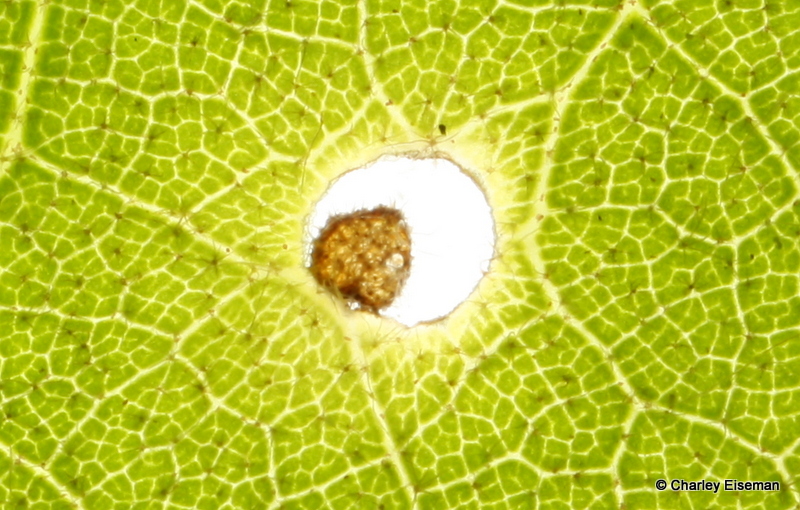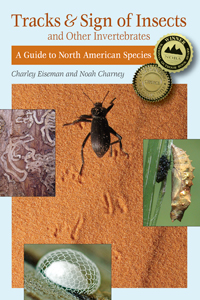At the moment there are 648 observations on iNaturalist purporting to show the “oak shothole leafminer” (Agromyzidae: Japanagromyza viridula). Apparently I have personally verified 93 of them, in almost all cases based on the presence of leaf mines. Virtually all the rest are just photos of holes in oak leaves, many of which probably were made by this fly, but in most cases there is no way to tell for sure. I wrote about this species last year, and for your convenience I’ll copy and paste the relevant portion here:
This fly is called the “oak shothole leafminer” because of the holes that open up in the leaves as a result of feeding by adult females. They use their ovipositors to stab the young leaf and then turn around to drink the juices from the wounds. As the leaf continues to expand, a hole opens around a tiny necrotic disc that forms around each puncture (upper right in the photo below). Holes also open up around eggs that are inserted in the leaf (lower left).

In this closer crop you can see the tiny white (because it’s backlit) puncture from the ovipositor near the right edge of the necrotic disc.

There are often multiple holes per leaf. Eventually the necrotic discs drop out, leaving just the “shotholes” as evidence.


Japanagromyza viridula seems to have just one generation per year, but unlike most agromyzid flies with this type of life cycle, adults emerge within a few weeks after the larvae exit their mines, rather than the following spring.

(End quote.)
So, just to be clear, these holes do open at the beginnings of leaf mines of this species (as in the left side of the first photo above), but most of the holes are just caused by the females stabbing the leaves and they have nothing to do with leaf mines. I’ve done my best to discourage folks from adding pictures of holes in leaves without any associated leaf mines to my iNaturalist “Leafminers of North America” project, and early on I left comments pointing out that these holes can be made by other things, but I gave up due to the sheer volume, so take that distribution map with a grain of salt!
Anyway, back on May 25 I noticed this holey leaf on one of the little red oak saplings I haven’t had the heart to mow in the unkempt meadow that is my yard:

If I posted this photo to iNaturalist, it would probably become elevated to a “Research Grade” observation of Japanagromyza viridula within minutes. The thing is, though, when I flipped the leaf over, I found that all of the holes had been made by three little sawfly larvae:



These oak-feeding sawfly larvae with forked spines belong the the genus Periclista (Tenthredinidae). This is the first time I’ve ever seen them in my yard and I don’t know if there’s any way to tell what species they are without rearing them to adults, which don’t emerge until the following spring. So far I’ve reared three different species from oak elsewhere in Massachusetts, and the larvae did show some differences in the head pattern; if those differences are significant, then the ones in my yard might be P. albicollis, which looks like this as an adult:

(Incidentally, when I tried uploading the photo of the holey leaf to iNaturalist just now, the machine learning auto-ID feature told me it was “pretty sure” my photo depicted the work of some kind of chrysomelid leaf beetle; all of its “top suggestions” were likewise leaf beetles and it made no mention of agromyzid flies. Still wrong, but at least it doesn’t think all holes in oak leaves indicate “oak shothole leafminer” as some human observers do. Is my Tracks & Sign of Insects book partly to blame for this perception? Probably.)
I’d be remiss if I didn’t mention that the first photo of the sawfly larvae above also shows galls caused by an undescribed species of midge in the genus Contarinia (Cecidomyiidae), another thing I hadn’t found in my yard before. Just let the squirrels and blue jays plant a few acorns in your yard and your local biodiversity will skyrocket! Another leaf on that same sapling had some different sawfly larvae (Pergidae: Acordulecera) munching on the edge of it.

No way to put a species name on those even if I did rear them to adults; they would pretty likely turn out to be something in the Acordulecera dorsalis complex, which no one has yet tried to sort out. We know so little about some of the most common bugs around us.



So interesting! (As always)
Your posts are always worth reading. Thanks Charley!
Another fascinating post, thanks for sharing!!! I swear I read something about a 2022 calendar but can’t find it now…..I missed the opportunity last year and was very sad about it!! If you are offering one this season, please let me know.
thanks Inger Lamb Beaverdale, Iowa
Guess I’ll have to re-think my go-to, impress-the-neighbor factoid about oak shothole leafminers. Knowledge can be painful.
It’s a tribute to your skill as an educator that I, who knows almost nothing about insects, can read and enjoy these posts. And feel as though I’m learning something. Though often what I’m learning is a) there’s a whole tiny world most humans have no clue (or consideration) of. And b) there are some very alien looking, gorgeous bugs all around us. Just living their lives. (And to think there are even smaller, also beautiful, also fascinating, molds and bacteria and viruses). I bristle when I hear people say permethrin is “harmless”. Thank you!!
Great post. I have been guilty of calling them the same. Oops. I was in the field with another bug book author a long, long time ago and this sign was described exactly as you showed it above. I think I am mistaking many holes in leaves for this!
PS: What kind of camera are you using to get your macro photos? They are amazing!
Info here: http://charleyeiseman.com/photography/